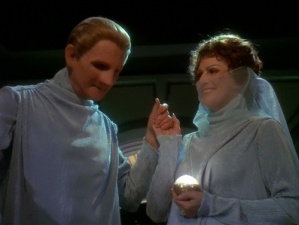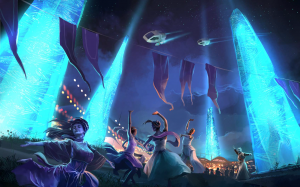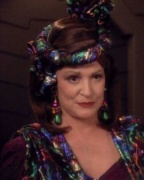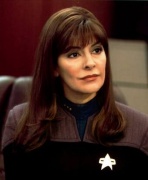Betazoid
From Star Trek: Theurgy Wiki

- Zinnia Shu
- Andram Obair (KIA)
- Rem Kile (KIA)
- Regiene "Reggie" Suder, callsign "Gemini"
- Stellan Foster (Stasis)
- Akel Isavid (KIA)
- Kythalie Benmual
- Zephyr Praise (KIA)
- Elro Kobol
- Ranaan Ducote (KIA)
- Winter Bannin (KIA)
- T'Panu (KIA)
- Scosche Bellde'side (KIA)
- Sjaandin Fedd (KIA)
- Soo Young Seung (KIA)
- Garen Nelis (KIA)
- Faye Lintah Eloi-Danvers
The Betazoids were a peaceful humanoid civilization originating from the idyllic, verdant Federation planet Betazed. The world was a valued member of the Federation, and its people could be found across Federation space, including Starfleet. Betazoids appeared almost identical to Humans, but differed in one major way: they were naturally telepathic, developing mental abilities during adolescence. The potency of this ability varied between individuals, but it resulted in a culture where honesty and directness were fundamental. See also Psionic Abilities
Psychology
Outgoing and friendly, the typical Betazoid is calm, quiet, peaceful, gregarious, and amicable. Betazoid altruism and compassion are renowned throughout the galaxy. Betazoids generally feel a genuine sense of satisfaction in helping others. Using their telepathic abilities, some Betazoids attempt to foster understanding between alien cultures or those with differing points of view. Many combine their telepathy with a study of psychology, to help others understand their feelings, anxieties, or phobias. Those Betazoids who join Starfleet often combine these two impulses into one, signing on as ship's counselor, where they can help fellow crewmates and advise on diplomatic matters.
Because they could sense the turmoil in the minds of those around them caused by discord, Betazoids had a strong predilection toward harmony. They preferred to resolve conflicts through non-violent means, and their dedication to peace and cooperation was well-known throughout the quadrant. Event the typical man on the street or shopkeeper worked to resolve their disputes with a minimum of fuss. Many people regard Betazoids as pacifistic, and while many of them are, this is no means a universal trait, as the Jem'Hadar learned to their dismay during the occupation of Betazed.
Generally, Betazoids valued candor and integrity (though they were capable of lying). Sometimes this rose to the level of brutal honesty, and those unaccustomed to this characteristic could find Betazoids arrogant, rude, or off-putting. They do not like liars; once lied to, it could be very difficult to regain a Betazoids trust.
Physiology & Appearance
Externally, Betazoids were physically indistinguishable from Humans in every aspect but one: the irises of their eyes were completely black. They possessed the same average height, weight, and build as Humans. Most of them have skin tones ranging from pink to olive, and black or brown hair, though darker hues of skin and lighter hair are not unknown. They live roughly 150 years of age and at 18 they are considered adults. They had few internal and developmental differences, such as different placement of organs and a ten-month gestation period. They could cross-breed with Humans, along with other humanoid races like Klingons and Tavnians. Betazoid iris coloration was present in half-Betazoid individuals such as Deanna Troi, but in those with less Betazoid blood such as Devinoni Ral and Walter Pierce (who were only ¼ Betazoid), normal Human eye coloration was possible. (TNG: "The Price") Betazoids had a gestation period of ten months. (TNG: "The Child")
Betazoids reached rapid eye movement (REM) sleep at a different frequency from other humanoids. (TNG: "Night Terrors")
In mid-life, Betazoid females underwent a physiological change known as "The Phase" during which their sex drive increased by a factor of four or more. (TNG: "Manhunt")
Mature Betazoids could also suffer from Zanthi fever, which caused them to lose control over the projective aspect of their empathy. That could result in people around them acting as if they had experienced the same general emotional state as the affected Betazoid, though they were directed by their own subconscious desires, fears, and other emotions. (DS9: "Fascination")
Telepathic Abilities
Betazoids were natural telepaths, an ability centered in their paracortex, with psilosynine being a main neurotransmitter. (TNG: "Dark Page") Most developed their telepathic skill in adolescence, but a few were born with their telepathic abilities already active, such as Tam Elbrun. (TNG: "Tin Man") These individuals were almost always extremely talented and powerful in telepathic terms, but also unable to screen out the noise of other people's minds, so they generally suffered mental problems of varying severity depending mostly on when the problem was diagnosed. On the other end of the scale were a few individuals who developed psionic abilities which were far below average for the species (for example, Lon Suder). Those Betazoids were barely able to sense even strong emotions (empaths) of other people, much less thoughts.
The common psionic abilities of Betazoids extended from sensing thoughts and/or emotions, over projecting thoughts and/or emotions, to manipulating the minds of others. (TNG: "The Price"; DS9: "Fascination") How capable they were in performing any of those feats depended somewhat on their genetically-defined psionic strength, their psionic training, (TNG: "Haven") their familiarity with the scanned being, their general mental and physical condition, and the species of the subject race. Betazoids also felt the emotions of animals, and thus were wary of getting too involved in the "passion of the beast" in situations in which they had to rely on an animal, like when riding a horse. (TNG: "Pen Pals") Betazoids also were able to read the emotions and thoughts of non-corporeal beings such as Nagilum, the energy vortex, or to gauge the mental prowess of beings such as Q. Other times they were totally unable to read corporeal creature's minds, such as Ferengi and Changelings. Data theorized that the reason they may not have been able to read Ferengi was the structure of their brains. Data himself was able to be read by Deanna Troi when his brother Lore used the emotion chip to transfer powerful emotions to him. At one point, when Troi lost her empathy temporarily she commented that Will Riker was like a holodeck character to her, completely devoid of emotion, as if she had never experienced a lack of empathy from any sentient before. The Traveler was also not able to be read by Troi.
Inter-species reproduction involving Betazoids often affected the psionic abilities of the offspring – most commonly the children of such a union developed empathic abilities as their primary psionic talent, while their telepathic abilities, though existing, were rather below average for Betazoids. Usually the telepathy of these half-breeds, without extensive training, was limited to communication with other empaths or telepaths and full telepathic contact with emotionally very close persons (for example, an imzadi). All full Betazoids were unable to read the thoughts of Ferengi, Breen, Ullians, and Dopterians, but some half-Betazoids were occasionally successful in sensing the emotions of some of these species. Additionally, full Betazoids seemed to even be able to psionically influence some of these species. (TNG: "The Price", "Ménage à Troi"; DS9: "The Forsaken", "Fascination")
Languages & Names
Betazoids spoke Betzed, and learned Federation Standard. They placed their given name first, family name second.
Family Names
- Elbrun, Grax, Hagen, Morganth, Stadi, Suder
- Elbrun, Grax, Hagen, Morganth, Stadi, Suder
Male Names
- Andrus, Lon, Reittan, Tam, Talloc
- Andrus, Lon, Reittan, Tam, Talloc
Female Names
- Azuma, Deanna, Jemma, Kestra, Lwaxana, Yaxara
- Azuma, Deanna, Jemma, Kestra, Lwaxana, Yaxara
Culture & Tradition
Betazed was an egalitarian society of telepaths who celebrated intimacy in all forms. This dictated family dynamics, what they believed in, and what they placed importance in. Unlike other planets where physical strength shaped how society was formed, the Betazoids' mental abilities meant emotional intelligence rather than physicality shaped their society. The importance of intellectual aspects for Betazoids was exemplified by their fondness of nudity. Every important Betazoid celebration - birth, death, and marriage - was held in the nude. Until Betazed made first contact, much of their lives were lived in the nude as well. Once a person's emotions are laid bare for all to see, there is very little room for shame in other aspects of their life - because thoughts are far more intimate than a person's outside appearance.
Noble Houses and Social Class
Although their power has dwindled in the millennial since their founding, the noble houses of Betazed maintained a privileged status in Betazoid society. The houses have been a Betazoid institution since before the time of Khrysaros, their origins intertwined with Betazoid spirituality and the inception of the priesthood. It is said that the houses had their origins in a place far beyond the stars, and were brought to Betazed with the first inhabitants. While this story may or may not be true it had an apocryphal impact on Betazoid history, and the houses retain much of their previous power and importance even into the 24th Century.
Although most opportunities are open to all Betazoids, a cultural distinction still existed between the wealthy great houses and the commoners. Betazoids are quick to downplay this in the presence of outsiders, but claims of noble blood remain highly respected and are accorded special significance during religious rites. The Betazoid priesthood has become an open brotherhood, but house affiliation or membership remains the surest method of entrance.
Family
Families on Betazoid were matrilineal and children took their mother's surname when they were born. Children born to Betazoid/alien pairings differed on how they were named, but mixed children born to one of the Great Houses were always known by a female surname on Betazed itself so other citizens knew which House they belonged to. If their father was Betzoid and their mother alien, the child would have their father's surname on Betazed and thus his House as well. Betazoids had an amazing capacity to love and be loved in return. Monogamous couples were the norm on Betazed, but it was not uncommon to have one partner with two or more spouses or a group of spouses who lived with and love one another. Children were raised by the family unit they were born into and grandparents played a special role in their rearing. When a child was born, a 'blessed' grandparent was chosen. The blessed grandparent would raise the child if something ever were to happen to their parents, and was afforded a special role in the child's life. When a Betazoid woman is pregnant, grandparents became highly competitive with one another, plying the parents with gifts and assistance in hopes of becoming the blessed grandparent.
Beliefs
Betazoids were polytheistic, as evidenced by an exclamation used by Lwaxana Troi, "Thank the four deities you're here". (TNG: "Manhunt")
Ancient Betazoid religious lore tells of the Four Deities who shaped Betazed. Betazoids believed they were born from the Four Deities' thoughts and populated Betazed. Unlike many deities, the Four Deities did not possess any special abilities beyond the highest level of telepathy a Betazoid could achieve. They lived among their thought creations and taught Betazoids how to harness their telepathy. After hundreds of years, the Four Deities grew tired of their time on Betazed and wished to explore the intricacies of the mind, so they traveled into the thoughts of every Betazoid to begin their new journey. To this day they still travel through the dreams, hopes, and thoughts of every Betazoid.
Next to the Four Deities was the religious concept of the Great Fire. The Great Fire was not a literal place people go, but a moment before death where a person experiences an endless tortuous fire flaying their would from their being. It lasted only a moment for those watching the death, but was a neverending pain for the person who dies, their entire past and present erased in a wash of flame. The Great Fire was gifted to particularly cruel people by the Four Deities as punishment for a life squandered.
Marriage Customs
The Betazoid view of marriage is also different from that of many other cultures. To cement ties between households, the ancient Betazoids practiced a tradition of arranged marriages, in which the betrothed are genetically bonded to each other at birth. A suitable genetic partner must also be selected in order to produce healthy children who can contribute to society. Traditionally, love is considered a separate issue from marriage in Betazoid culture. A Betzoid may form a psychic bond with someone with whom they are close. This individual is referred to as imzadi, which loosely translates as "beloved" (a term with overtones of "true love" or "soul mate"). The tie between a Betazoid and his imzadi is difficult to understand. It is a deep connection that lasts for a lifetime, no matter what course the lives of the two my take. Many young Betazoids have started marrying their imzadi instead of their genetically bonded partners, which has drawn strong criticism from some noble houses.
Betazoid weddings were seen as a celebration of love and therefore ceremonies customarily required the bride, groom, and guests to go without clothes, to honor the act of love being celebrated and symbolize that all parties entered the agreement openly. Only the most tradition-minded Betazoids hold to these customs in the modern-day. (TNG: "Haven", "Cost of Living"; Star Trek Nemesis)
- Betazoid Weddings of the 2370s
Social Telepathy
Telepathy is the central organizing theme of Betazoid society. Among their own people, Betazoids communicate telepathically. Betazoid towns and cities are filled with an undisturbed (some off-worlders may say eerie) silence. Many resort to speech among non-Betazoids, out of respect, though this isn't universal. Betazoids dislike species whose minds they cannot read, such as the Ferengi, Breen, and Dopterians, feeling uncomfortable in their presence; this remains their only unresolved prejudice. Betazoids who lose their telepathic ability feel handicapped, frightened, and alone, with many choosing to lead their telepathically mute lives off-world among other non-telepaths.
Other Traditions
There are, of course, thousands of other aspects to the rich culture of Betazed. Many schools of meditation exist on the planet to help others learn to connect with the natural world. Betazed also has a rich martial arts tradition; Betazoid styles meld telepathy with combat maneuvers as the fighter tries to anticipate his opponent's moves and counteract them almost before they begin. Dancing is a highly developed art form on Betazed, as is mind-imaging, a form of interactive storytelling where the participants telepathically link together to share mental images.
Due to their telepathy, Betazoid culture embraced honesty almost to a point considered rude by other cultures. Lwaxana Troi, on numerous occasions, commented on her befuddlement at the Human practice of fibbing to spare others' feelings or for politeness' sake. (TNG: "Haven", "Dark Page")
While eating, Betazoids expressed thanks for their food by ringing a gong at intervals. (TNG: "Haven")
Betazoids had a complex hereditary nobility; prominent Betazoid diplomat Lwaxana Troi, for example, was "Daughter of the Fifth House, Holder of the Sacred Chalice of Rixx, and Heir to the Holy Rings of Betazed." Betazoid tradition had children genetically bonded to a future spouse. (TNG: "Haven")
At one time, it was fashionable for Betazoid women to wear elaborate wigs that caged small animals. The practice, which was cruel to the animals, was stopped when one (unknown) woman stood up against it. (TNG: "Half a Life")
Astrography
Solar System
Betazed lied in a system of nine planets orbiting a single Type G2V yellow star called Hainara (Beta Zeta Veldonna). An abundant source of deuterium, as well as the system's close proximity to other Federation core worlds such as Earth, Tellar, and Vulcan, maked Betazed strategically important.
HYNOZAD (Hainara-I)
- The innermost Class F planet, Hynozad, appeared as one of the brightest objects in Betazed's sky. Hynozad was geologically inactive and had a smooth, light-colored surface, making it one of the most highly reflective planets ever discovered. Its close proximity to its sun means it gathered a great deal of light. Hynozad was little explored, for the Betazoids had long attributed a religious significance to it and did not wish to treat it as just another planet to be explored and cataloged.
HEMMAR (Hainara-II)
GAHN (Hainara-III)
LONITA (Hainara-IV)
BETAZED (Hainara-V)
- Betazed was the fifth planet of the Betzaed system. It is a Class M planet with gravity and atmospheric pressure approximating those of Earth. It had three small moons (Avandar, Merandar, and Keylandar). The moons all had distinct orbits and rarely appeared in the same section of the sky. When all three moons clustered together it was considered a time of great significance.
DARONA (Hainara-VI)
- Darona was the sixth planet of the Betazed system. It was home to a small Betazoid colony of which the capital city was Jarkana. Darona had a rose-colored sky and an atmosphere of serenity and natural beauty. I was known primarily as the location of a high-security prison for the criminally insane, as well as its agricultural, medical and scientific research facilities. The capital, Jarkana, lay to the east of the Jarkana Mountains. Jarkana spaceport was located just outside the city.
- Daronan spring water originated from Darona. The plants of cavat, crystilia, diomedian scarlet moss, draebidium calimus, frangipani, poinciana and teskalia trees, and zan periculi were grown on Darona.
- During the Dominion occupation of Betazed in the year 2374, less than 1,000 Dominion troops were stationed on Darona due to its low population. (TNG novel: The Battle of Betazed)
PROXON, AVANDAR, KHRYSAROS (Hainara-VII-IX)
- The three outer planets were gas giants with rings and several icy moons each. Explorations of these planets and their satellites had yielded little of interest. Proxon, the closest planet to Betazed, had a small research station in orbit for testing equipment used to measure gaseous anomalies. The remaining two were called Avandar and Khrysaros.
Betazed Geography
Looking like a large cloudless oceanic planet from space, Betazoid is a shockingly blue world. Still, even though its hydrosphere is slightly more prevalent than Earth's, the temperate (albeit occasionally stormy) weather means that more of the landmasses are habitable. Betazoids, therefore, live on just about every part of the planet, and the continents are riddled with a disproportionate number of placid lakes.
Betazed has five continents and hundreds of islands grouped in archipelagos. Along the tropical latitudes, the planet is ringed with a band of lush rainforest. The temperate bands alternate between vast wetlands, grasslands, and forests. Betazed's numerous islands mainly consist of rocky, steep mountains wreathed with lush vegetation and tropical canopies. Long rainy seasons typify spring weather on Betazed, but the summers remain fairly temperate and comfortable. Autumns and winters also tend to be mild in comparison to weather patterns on other planets.
Because Betazed is less geologically active than Earth, mountains are rarer and less severe on its continents. ONly two of the continents have more than a single range of central mountains. Betazoids who see the more severe mountains of Earth and Andoria often have difficulty comprehending their sheer starkness at first. Indeed, the climate and geography of Betazed combine to give Betazoids a feeling of security. Used to temperate climes and forgiving geography, many Betazoids find other worlds stark or even hostile by contrast.
The Betazoids do not use weather-control technology, as they believe it involves unnecessary tampering with nature. As a result, settlements on Betazed do occasionally suffer from typhoons and other natural disasters that are uncommon on most civilized worlds. The world's three moons cause significant tidal forces, and, without weather-control technology in place, such storms are permitted to rage unchecked.
Places of Interest
- Medara-Rixx
- Medara-Rixx, the twin city capital of Betazed, is located on the largest continent. The Ruling Council of Ministers holds sessions in the city, and each of the Great Houses of Betazed maintains a residence near the cities' center. Most of these residences border the vast Plaza of Contemplation, which rests in the center of the cities and serves as the focal point of the citizens' spiritual lives. While a plethora of smaller temples and sacred sites dot Medara's landscape, most large celebrations and holy days are celebrated in the great Plaza.
- Medara-Rixx is a large, sprawling place, made all the more beautiful because of its wholesale integration into its surroundings. Gardens abound, and many structures rise from the floor of the great swamp which cradles the city. The layout of Medara-Rixx appears intuitive to the casual observer, and it is - the cities' districts radiate outward from the central Plaza like the spokes of a great wheel, with religious and government quarters (including the residences of the great houses) giving way to business areas and finally to residences.
- Medara-Rixx is also a holy city, and as such contains many temples, tombs, and sacred monuments throughout its precincts. The Betazoids are careful to maintain their sacred sites; many members of the noble houses of Betazed have religious duties as well as temporal ones.
- Lake Cataria
- Lake Cataria is a scenic resort on Betazed. The shoreline of the lake twists and turns, creating many quiet private coves where people can enjoy themselves. The waters are crystal clear, and boating, swimming, and fishing are favorite pastimes in different sections of the lake. Once someone's day on the lake has ended several fine hotels and restaurants stand near the shores ready to shower patrons with attention.
- In 2371, a small village was planned on the shore of Lake Cataria, to accommodate the influx of Federation citizens relocating to the planet. These plans were abandoned following the Dominion invasion of Betazed in 2374. (ST - Tales of the Dominion War short story: "The
- Ceremony of Innocence is Drowned")
- Dalaria City
- The city of Dalaria has the largest spaceport on Betazed. Thousands of shuttlecraft arrive and depart from Dalaria daily. The spaceport is also equipped with large cargo transporters to handle commerce. Dalaria is most famous as the site of the biennial Trade Agreements Conference. During this important economic summit, Betazoid arbitrators help determine the value of different goods and planetary currencies across the Federation. Although the negotiations are difficult, the delegates trust the Betazoids to be honest and fair in their dealings. The Trade Agreements Conferences have earned the Betazoids many admirers across the UFP.
- The University of Betazed
- The University of Betazed is recognized throughout the Federation as one of the leading centers of psychological study in the galaxy. Students from many different member worlds seek admission to the university; members of races with telepathic powers are often particularly eager to take advantage of the university's advanced courses for such students. In addition to education, the university conducts psychological research on every member race of the UFP and several nonmember races.
- Because of the spirituality of the Betazoids, there are many standing stones, quiet shrines, and other religious monuments dotting the surface of Betazed. Unlike many other modern cultures, the Betazoids are slow to give up their mythical traditions, preferring to mesh them with the advanced technology of the UFP rather than forsake the spirits.
- Pillars of Rixx
- Rixx is the ancestral home of the Fifth House of Betazed, one of the oldest and most prestigious Houses on the planet. Since its origins, the Fifth House has spread over the planet and into space, but Rixx remains an important location for the House. Letsana was the founding member of the Fifth House and a warrior poet. She traveled through Betazed for many years until she came upon Rixx, where she found the commoners subjugated to a warlord of the Fourth House. Unable to stand by as so many people suffered, Letsana challenged the warlord to a duel, but was promptly rejected. Unwilling to give up, Letsana apologized and offered to play music for a feast the warlord was holding in her manse. Greedy and prideful, the warlord agreed and Letsana played beautiful music for the warlord all night, carefully using her powers of telepathy to study the aristocrat as she feasted. At the end of the night, using the knowledge she gained about the warlord, Letsana sang the most humiliating song about her and tricked the warlord to challenging her to a fight. Letsana won the fight against the warlord and disbanded her House. She freed the people under the Fourth House’s rule and, drinking deep from the Sacred Chalice of Rixx, proclaimed Rixx to be under her protection and the protection of her new house – the Fifth Great House. The Pillars of Rixx once housed the Sacred Chalice of Rixx, which was moved centuries ago and given, along with a title, to a member of the Fifth House for safe-keeping. This coincided with the re-emergence of the Fourth House and demands of the House to return the Chalice and the title. After a decision by the Council of Ministers a century ago to cool the heated conflict bubbling between the two Houses, it was decided that the title ‘Holder of the Sacred Chalice of Rixx’ must be passed between the two based on merit and overseen by the Ministers. The title is one of the only Betazoid titles that must truly be earned. The current holder of the Chalice of Rixx is Lwaxana Troi.
- Temple of the Great Houses
- The Temple of the Great Houses is dedicated to the Great Betazoid Houses which no longer exist. The last member of the House is buried within the Temple’s walls and the stories of the House are inscribed on their tomb’s walls. Priestesses dedicate themselves to learning all the stories on one tomb, so they can recite them on request to any person who enters the temple – so that the Great House is never forgotten. If someone believes they contain blood of a Great House, they must go to the temple and speak with the priestesses who run the temple. The priestesses, using their powers of [[[telepathy]]]], are able to look into the person’s thoughts and, having memorized the stories of the Great House, see if the person is truly a member of the House. If they are, the House is reinstated and the tomb is sealed until it is needed again.
- Glowing Spires of Bren'Dunn
- The Glowing Spires of Bren’dunn are naturally-occurring rock formations jutting from Betazed’s surface. The rocks are translucent and glow with an inner light depending on the time of year. On most nights, light of the spires shines onto the Betazed sky creating hazy shapes of luminescent figures stretching far into space.
- Before Betazed achieved space travel, it was widely assumed the lights in the sky were the residual thoughts of the Four Deities spewing into space. Each of the spires in Bren’dunn is a dedicated portal to a different Deity. As the sciences advanced, Betazoids came to understand the lights were simply a natural phenomenon, but the locations remained holy sites.
- Once a year, religious Betazoids make a journey to Bren’dunn to pray at the spire of their chosen Deity. If their prayers are heard, the spire will light the night sky and the Betazoid is blessed with the grace of the deity for the upcoming year. Because there is always a constant stream of Betazoids coming to the spires to pray, it is also the site of a massive ongoing party. People camp beneath the spires, tell stories, drink, and make merry under the spires of the Deities. No monks care for the ground of the Glowing Spires, but it remains a clean, safe place to visit as only a fool would create litter under the watchful eyes of the spires.
History
Early Betazoids had a strongly religious outlook stemming from a combination of their telepathic sensitivity (giving them insight into communities and the well-being of their fellows) and their forgiving homeworld (which gave them a sense of placement-the feeling that the world was designed to suit them).
The ancient history of these Betazoids remains shrouded in myth and legend, and the Betazoids seemed to prefer it that way. Many tales spoke of the gift of telepathy which the Betazoids earned from the spirits through their stewardship of the natural world. Other stories told of great wars fought with an evil race of beings possessing similar telepathic skills known as the "demons of pain and anger." These entities floated through walls and barred doors. When these entities descended upon a community, they brought with them anger and strife. Said to be able to make primitive weapons appear out of thin air, whole villages would be found to have massacred each other. An orgy of violence spread across the land. Most modern anthropologists assume that these entities were similar to the emotion-feeding creatures like the "Redjac" encountered by the Constitution-class U.S.S. Enterprise.
The Legend of Khrystaros
All Betazoids knew the earliest legends of the clergy that formed around Krystaros and his followers, a group of legendary saviors who honed Betazoid telepathy in order to fight off incorporeal "demons." The mystical hero, Krystaros, used her great mental powers to defeat the flickering, shadowy ghost-like enemies from the stars While it appears as though all Betazoids possessed some rudimentary form of telepathy, Khrystaros found a way, according to the stories, to develop this potential. She gathered several acolytes and trained them to battle the entities. They, too, developed incredible telepathic powers. The greatest among them was Rixx, who banished hundreds of these demons and usher in a golden age. For millennia afterward the clergy spread his teachings and served as the heads of a secular government, especially the acolyte Rixx, who was granted a set of Holy Rings which are said to have the power to summon Khrystaros again during Betazed's time of greatest need. These same rings are now in the possession of Lwaxana Troi, Betazed's ambassador to the Federation; they are the ancestral property of the Fifth House.
Scholars credit the teachings of Khrysaros with the unification of Betazed. Before him, Betazoids organized into various kingdoms and city-states often fought each other. Eventually, a theocratic oligarchy gained control of the planet and brought most of the fighting to a halt. Only nobles were allowed to enter the priesthood, and the priests dictated life on Betazed. Armed with the combination of righteous responsibility and the artifacts of Krystaros, the priests defused potential conflicts, directed the growth of civilization, and comforted their brethren with the knowledge that Betazoids held a cherished place in the scheme of life.
As Betazoid technology continued to advance, the need for a more secular government became apparent. While the priesthood had succeeded in bringing feuding houses and nation-states together into a unified world governing body, their resistance to social freedoms and technological progress remained a hindrance. Betazed was still primarily a spiritual society, ruled by its beliefs, its ancient faiths, and its strong ethical nature. As the world prepared for its first spaceflight, conflict was inevitable.
It wasn't until a religious schismatic named Dainara proposed the formation of a separate, secular government that Betazed industries started to evolve beyond their religiously-ordained roles. The progressive priest Dainara was a scion of the Third House, and he argued that Betazed had finally grown beyond its ancient spiritual roots. He thought that the priesthood was no longer able to govern the world effectively, and he advocated a radical separation of the secular and the spiritual. He spoke of the new responsibilities inherent in Betazoid technology, of the casual acceptance and potential misuse of Betazoid telepathy. Dainara was a charismatic leader and his message found many willing ears; unfortunately, none of them belonged to his fellow priests or nobles. In the end, his eloquence mattered little. Even the discovery of other worlds and of space travel wasn't enough to put the nail in the coffin of theocratic authorities. The maiden flight of the Avandar took place the following year in 2139. Although the priesthood did not like the perceived spiritual ramifications of spaceflight, they accepted progress on their own terms - as a way to spread Betazoid teachings beyond their world, possibly to other sentient species among the stars. As it turned out, they wouldn't have to wait long.
The Terabian
Betazoid history took a turn several years later with the discovery of nearby Terab IV. First contact with the Terabian occurred during the flight of the first Betazoid warp-capable vessel, the Avandar. The Terabian were a humanoid species inhabiting a world slightly more than four light-years from Betazed, and contact was greeted with enthusiasm on both worlds. Both species had reached approximately the same point in their development; however, Betazoid agrarian technology was superior to the Terabian versions of the same, while the Terabian excelled at materials engineering and electronics. The cultures began to trade, sharing their resources and technology. The Betazoids were initially startled to learn that their Terabian neighbors did not possess telepathic abilities. While they adjusted quickly to their nontelepathic neighbors, there were those among the priesthood who thought the Terabian flawed or inferior as a result. Such beliefs would be the seeds of conflict in the years to come.
As the years passed, settlers also traveled between the two worlds, and a degree of intermarriage began. All was not well on Terabia, however. While Betazoid telepathic ability was initially viewed as a curiosity, more to be marveled at than feared, the Terabian slowly began to distrust their new allies. This was partly a result of the Betazoid priesthood's assertions that telepathy was a gift and should be used widely and freely. Although there were those who recognized the dangers in this view, especially when dealing with a relatively unknown species, their voices were largely ignored. As a result, the Terabian perceived a decidedly superior attitude among the Betazoids; it was a perception that would ultimately lead to open resentment.
This resentment initially took hold in the mercantile sector, with Terabian traders accusing their Betazoid counterparts of unfair practices and advantages. Since the Betazoid predilection for honesty is now well known, it is doubtful that such accusations were true. However, they were just the fuel needed to fan the growing flames of suspicion on Terabia. Fear grows most quickly when it is accompanied by misunderstanding, and in this case, that adage held true.
The Betazoid settlers living on Terabia were quickly rounded up and thrown into makeshift internment camps to protect them from paramilitary groups roaming the streets and assaulting Betazoids. The Betazoids who avoided incarceration increasingly turned to violence to protect themselves; conflict erupted between rival Betazoid and Terrabian gangs. Fearing a retributive strike by the "mind-readers," Terabia launched a preemptive strike against Betazed itself. While neither side had amassed much of a military arsenal, the ensuing war was protracted and brutal, with the Terabian offering no quarter. After nearly seven years of fighting, with neither side gaining the upper hand, the Terabian finally agreed to enter into negotiations with Betazed. Betazed sent diplomats to resolve the situation. After lengthy negotiations, they won the freedom of interred Betazoids, persuaded the Betazed terrorists to lay down their arms, and orchestrated a mass exodus from Terab IV. Speculation continues among historians regarding the Terabian change of heart; many feel that it reflects the increased knowledge and understanding the Terabian gained from the Betazoid prisoners in their own internment camps.
The ruling priesthood on Betazed had already realized that their ways were becoming outdated though most refused to admit it. Their extreme position of the Betazoids as "blessed" or "chosen" people made it difficult to negotiate with outsiders. However, in the wake of the war, they could no longer ignore the obvious. Thus, in their time of need, they turned to the man whom they had ignored so many years before. Dainara took the lead in the negotiations with the Terabian. The Terabian Armistice was negotiated, and a provisional council was established until a secular government could take its plac.e Large-scale reforms were implemented and discrimination based on social class was abolished. The Ruling Council was eventually formed in the wake of provisional rule, and Betazed began the long process of rebuilding. The Council's first act was the promulgation of the Code of Sentience in response to the conflict with the Terabian, to guide Betazoids in their conduct among alien species. As a result, Betazoids prefer not to use their telepathy on a non-telepath without permission.
Code of Sentience
Perhaps the most lasting contribution to come out of the spiritual arm of the provisional council was the Code of Sentience. Spearheaded by Dainara, and influenced heavily by his teachings, this code set down indelibly the duties, responsibilities, and prohibitions of Betazoid telepaths. Betazoid telepathy was indeed a gift; however, the people of Betazed needed to respect the gift and use it wisely, especially during this new age of exploration and contact. The Code would ensure that the mistakes made during the Terabian conflict would never be repeated. Through careful adherence to the Code of Sentience, the Betazoids have avoided a repeat of the Terabian situation and wide-scale persecution on other worlds. In fact, Terab IV eventually joined the Federation, their delegates requesting seats alongside Betazed's representatives, as a testimony to how far the two peoples have come.
| CODE OF SENTIENCE |
|---|
| The Code of Sentience guides Betazoids in their use of telepathy among non-telepaths. Individual Betazoids follow it to a lesser or greater degree, each according to his or her nature. Like any social code, it outlines what is acceptable, proper behavior, to both reassure non-telepaths and safeguard Betazoids: |
| Reading the mind of another without his knowledge is taboo. |
| Even when permission has been granted, the code forbids reading thoughts separate from the purpose of the mind reading. |
| The code discourages a Betazoid from divulging what he reads to another without permission. |
| It is considered rude for Betazoids to communicate telepathically with each other in the presence of non-telepaths. |
The Federation
With the Code firmly established, a long process of healing began with the Terabian. Betazed prospered once more, and peace reigned for over a century before first contact was made with the Federation. While at first, the Betazeds feared another dispute-with the realization that a great many other species weren't telepathic and, as a result, were predisposed to suspicion and dishonesty-the nascent Federation did have a positive outlook. Vulcans, while wildly different from Betazoids on an emotional level, could deal with other telepaths. Human optimism and compassion combined with the drive and loyalty of other Federation species won over the Betazeds, who eventually saw the benefits of joining the Federation. They became a quiet but visible component of Federation affairs by the 23rd century. Betazed applied for membership at some point not long prior to 2246, however, they had to make certain reforms to their government before they could join. By 2273, the Betazoids had finally dissolved the remaining religious requirements of their matriarchal world government and their application for associate membership was accepted. In 2294, Betazed had become a full member of the Federation. Their involvement soon proved essential to negotiating a number of important agreements of the time, including the Second Khitomer Accords and the Treaty of Algeron in 2311. A few traditionalists speak of the period before Federation contact as a near utopia, but most Betazoids feel that Federation membership has only made their planet a better and more equitable place to live.
Since joining the Federation, Betazoids distinguished themselves in numerous areas, particularly in diplomatic affairs. Improved relations with the Tholians were chiefly attributed to the skills of Betazoid negotiators. Starfleet specifically created the position of ship's counselor with Betazoids in mind. the talents of the Betazoids, coupled with their honesty and outgoing natures, earned them friends throughout the Federation. As a result, Betazed has become the host site for the Biennial Trade Agreements Conference, where the economic strengths of planets are weighed against the Federation credit and Betazoid negotiators help forge interstellar trade agreements among Federation member worlds, nonmembers, and the various peaceful starfaring neighbors of the Federation. The Federation would be hard-pressed to find another world so trusted to handle such delicate negotiations.
Betazed stayed a peaceful background member of the Federation up until the Dominion War in the late 24th century. Betazed had significant strategic value to the Federation. Its location close to the Vulcan home system and many other important regions made it a strategic linchpin to be strongly defended. For this reason, the defense of Betazed had always received the highest priority; normally, the Betazed system fell under the protection of the Seventh Fleet, and patrol vessels were a common sight in the system. During times of crisis, the fleet usually assigned a detachment of ships specifically to defend Betazed from possible hostile action. While Betazoids served in Starfleet as counselors and occasionally in other positions, the overall proportion of Betazoids that traveled off-world remained low.
The Dominion War
Unfortunately for them, the Dominion War would bring tragedy. In 2374, the Seventh Fleet was reassigned to the front lines and replaced with elements of the Tenth Fleet led by Admiral Masc. However, the Tenth was badly crippled and forced to retreat from the planet when attacked by Jem'Hadar and Cardassian forces. The Dominion had decided to conquer Betazed as a staging ground for attacks against the core worlds of the Federation and as a sign of strength-the ability to penetrate deeply and take even important worlds. Betazoid's outdated and minimal planetary defenses were not enough to fight off the occupation, and millions died from the orbital bombardments and Jem'Hadar assaults. This tactic came back to haunt the Dominion, though.
As a result of the Occupation of Betazed, the Betazed resistance was formed. It consisted of a loosely organized group of Betazoids united in their efforts to oppose Dominion rule. Ambassador Lwaxana Troi was one of the initial driving forces in creating this resistance. (ST - Tales of the Dominion War short story: "The Ceremony of Innocence is Drowned")
While Betazoids were not violent by nature, their innate telepathy made it impossible for the Founders to infiltrate the resistance. The ability to sense incoming troops and read battle plans also made it nearly impossible for the Dominion to blockade Betazed without exhaustive resources. Therefore, the Dominion committed those resources. They used Betazoid slave labor to construct Sentok Nor in orbit of Betazed. Sentok Nor was then used as a Jem'Hadar breeding facility and Dominion base of operations in the sector.
In 2375, the Betazed resistance successfully transmitted a plan to Starfleet at Starbase 19. Coincidentally, Starfleet had begun assembling the Twelfth Fleet at Starbase 19 to drive Dominion occupying forces from Betazed. However, the thirty-six ships comprising the fleet were destroyed in a pre-emptive attack by the Dominion. This caused Starfleet to send a special operations team in to execute the resistance's plan giving fleet admirals time to combine the 10th and 4th Fleets with Romulan forces in a final attempt to break the Dominion grip on Betazed. The Battle of Betazed that followed resulted in a Federation alliance triumph and the liberation of Betazed.(DS9 episode: "In the Pale Moonlight"; novel: "A Time for War, A Time for Peace"; short story: "The Ceremony of Innocence is Drowned"; RPG reference: The Dominion War Sourcebook: The Fires of Armageddon; TNG novel: The Battle of Betazed)
The Enlightened Mind Movement
After the Dominion War, Betazoid society was in turmoil and a resurgence of the Enlightened Mind Movement took place. The Enlightened Mind Movement saught to convince Betazed to withdraw from the Federation. It saw foreign influences as pollutants that were not only destroying Betazed culture but which were also cheapening the Betazois' spiritually bestowed telepathic gifts. It believed that the Dominion occupation was caused in part because of Betazed's membership in the Federation. This dissident group considered members of nontelepathic races to be inferior beings who wished to exploit the mental aptitudes of the Betazoids. They felt that Betazoids had forgotten the lessons learned from the Terabian conflict, and in a sense, they viewed the Federation government and its conflicts as a new kind of Terabia. The Movement believed that prior to the initial Terabian contact, Betazed was in the midst of a true golden age, and they hoped to recreate the utopia of the past once more by breaking away from the Federation.
Members of the Enlightened Mind Movement worked covertly, using their telepathy indiscriminately on non-Betazoids in an attempt to undermine ties between the Federation and Betazed. Many of the prejudices held by races against Betazoids (and telepaths in general) are a result of the efforts of the EMM. The extremists in the EMM had even planned terrorist attacks on their own people; Starfleet Intelligence had already foiled one planned assassination of Ambassador Lwaxana Troi.
Government
The great noble houses, descendants of Khrysaros' first acolytes, govern Betazed. They are ranked in the order in which their ancestor was believed to have joined Khryasaros. Rixx, for example, was the fifth to heed Khrysaros' call, and his descendants make up the Fifth House of Betazed. No other privileges stem from this rank.
Every ten years, the great houses meet in what is known as an omaz to select the five ministers who sit on the Ruling Council. This legislative branch passes laws, debate vital issues, allocates resources, and issues directives to the bureaucracy. The Ruling Council made all its decisions by coming to a telepathic consensus. Unlike many other governments, Betazed had no single ruler, speaker, or high commissioners, such as the Federation President, or the Ferengi Grand Nagus.
Instead, a vast bureaucracy served under the Ruling Council. This bureaucracy was divided into many different Relzari, or "departments", and handled the government's actual day-to-day operations. The High Office of Defense, for example, commanded the Betazed Defense Force (which served so valiantly against the Jem'Hadar during the Dominion War), while the High Office of Finance allocated resources to various government programs and handled other economic affairs. The High Office of Domestic Affairs worked to maintain the quality of life for all Betazoids. The Council itself appointed ambassadors and debated all diplomatic affairs. Although by tradition only women could lead a Great House or sit on the Ruling Council, there was no such restriction on men serving in the bureaucracy.
The Ruling Council of Ministers were advised by members of the Great Houses of Betazed. Most Ministers on Betazed were female, though nothing stopped men from participating in politics. Within the Council Hall, all debates and discussions were conducted telepathically. Although council members could shield their thoughts, such actions were frowned upon. Betazoids saw their legislature as sacred and believed that complete openness allowed the best decisions to be reached. Failure to participate fully meant the Councilor was shirking their duty to their constituents.
Much like a constitutional monarchy, the Great Houses wielded a small amount of legal power, but their job was mostly to represent the people of Betazed in social matters, leaving the actual governing to the Council of Ministers. There were 21 active Great Houses on Betazed, each with their own number. If a House faded from existence their number was never re-used; therefore, there existed a 45th Great House of Betazed, while there were only 21 active Great Houses. Titles within the Great Houses are inherited.
Betazoid society was strongly matriarchal. The eldest female in the family almost always leads her house, following in the tradition of Khrysaros' leadership. Lwaxana Troi, Ambassador to the Federation, for example, leads the Fifth House of Betazed. If the rule of a House was contested, the traditional rule went to the eldest eligible female within the House. If she rejected the title, then it extended to the first eligible Betazoid within the House regardless of gender. Other than the rule of the House, many titles were passed down throughout the line. Rather than being something inherited, other titles were bequeathed by the current holder on to one of their family members who they believed exhibited the qualities beholden to the title. This practice was notoriously fraught with Betazoids giving titles to their children, who didn't particularly exhibit any of the necessary personality traits to hold the title but are given it by their parents for the prestige. Technically, the ruler of the House had the ability to strip a title from one of their family members and give it to another more deserving, but this was rarely done lest the titles they've given came under scrutiny as well.
Unlike with Klingons, where nearly every citizen is a member of one House or another, Houses on Betazed were rare. Normally, they denoted a type of royalty and carried responsibility for the members of the Great House. Aside from advising the Council of Ministers, the Great Houses were patrons of their ancestral homes. If there were issues in the lands they used to oversee, the Great Houses were expected to donate food, resources, and whatever else they can in order to make sure the lands prospered. This benefactor role means members of the Great Houses were generally well-liked and respected in Betazed society for all they do for others.
Below the planetary level, Betazed was organized into provinces that were administered by governors. They handle the day-to-day affairs of the provinces and make certain that the directives of the Ruling Council were observed. Governors were seen as relatively low-level civil servants on Betazed and were rarely accorded much attention unless a province seemed to be mismanaged.
Legal System
The Betazoid legal system is the polar opposite to that of Vulcan. For Vulcans, logic and law are key, but for Betazoids, context and emotion are everything. A person who kills someone by mistake and genuinely feels remorse for their crime is likely to be judged less harshly than a person who bankrupted a colleague on purpose.
Petty crime is rare on Betazed. Distressed emotions, sadness, anger, and despair bleed into the world. A person suffering from them is a walking open wound, psychically, which most Betazoids find nearly impossible to ignore. The social system of support is so strong on the planet that petty crimes are mostly avoided, as citizens practice sincere compassion for one another as only a population consisting of telepaths and empaths could.
The direst crime someone can commit on Betazed is entering a person’s mind or dreams without their permission. It takes an incredibly powerful, albeit disturbed, telepath to do this. Only the most deranged mind would dare enter such an intimate space without permission. People who commit this crime are sentenced to life in prison and receive intensive therapy to try to help their psychosis; however, they are never released, in fear of the harm they could cause another person.
Sentences are carried out by a council of judges, but may be influenced by the aggrieved or the victim’s family. Perpetrators have a chance to open themselves to the people they have wronged – to utterly understand the pain they’ve caused and to allow their victim to feel their remorse. If this is done the victim has a chance to speak with the judges and perhaps influence their judgment.
It is important to note that, despite their advanced forms of governing, Betazed is essentially defenseless. Upon entering the Federation, they began disarmament and threw what considerable resources they had behind Starfleet. Betazoids make up a considerable number of Starfleet officers, but are spread out across the Galaxy. If Betazed were to come under attack, it would be up to Starfleet to protect the planet.
Noted Betazoids
Lwaxana Troi
Betazed Ambassador to the Federation
Image © CBSDeanna Troi
Famous Starfleet Officer
Image © ParamountCort Enaren
Betazed's Federation Councillor
Image © Starz




















